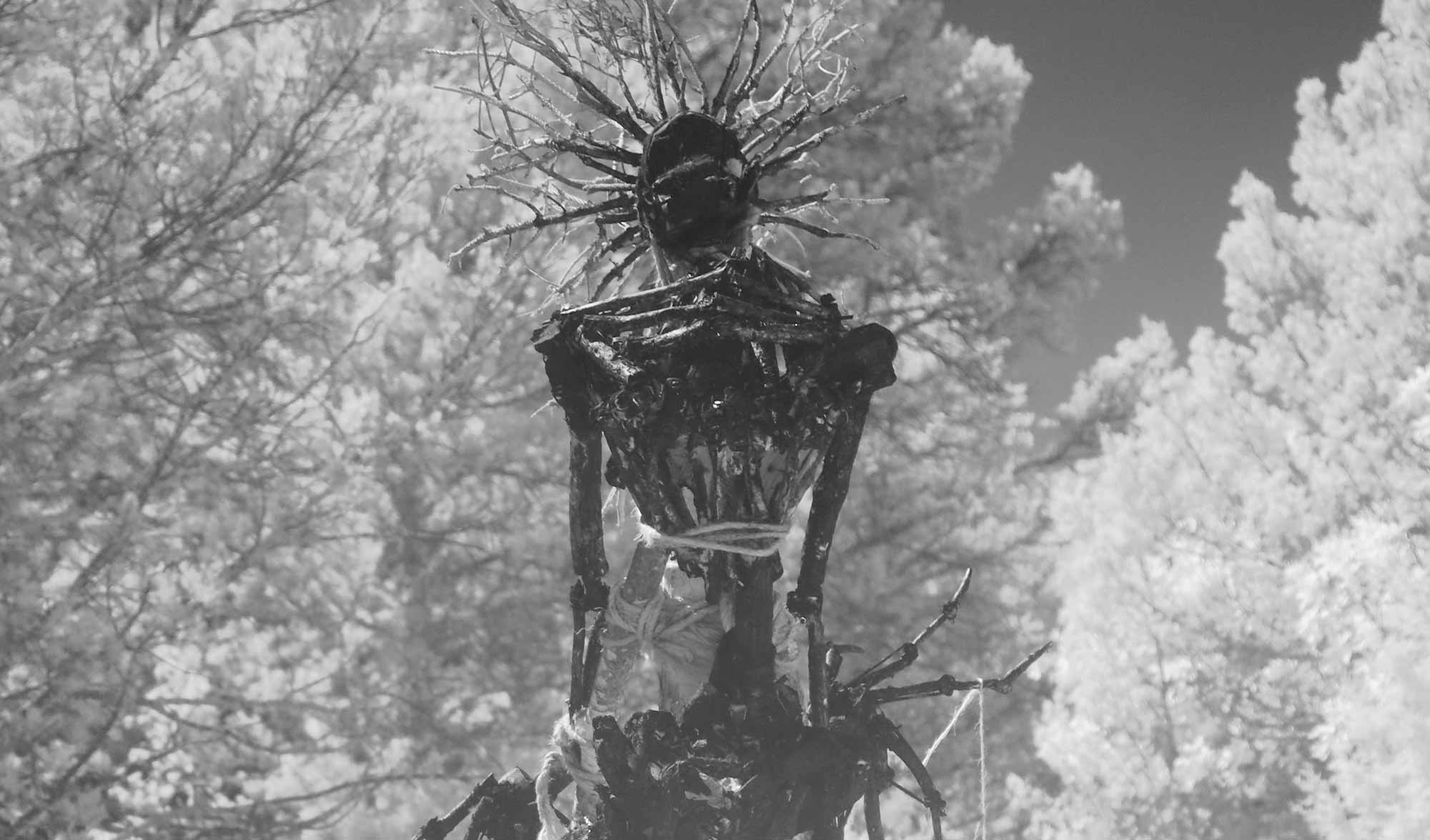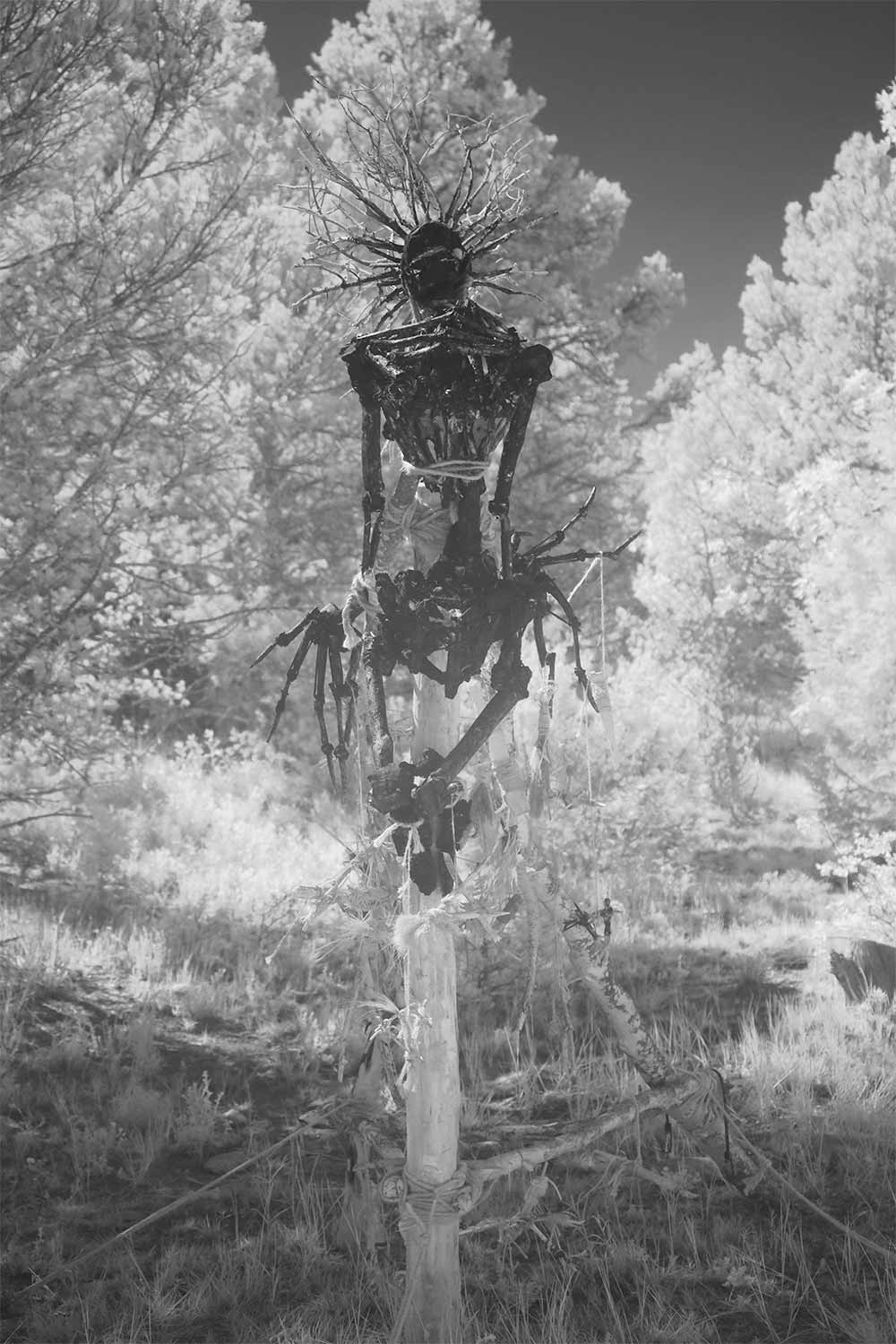

The Pinecrone
In Brief: An ambiguous and creepy wooden sculpture built to inspire campfire stories and new myths among the people who stumble across one.
“The attention to detail and skill in assembly was astounding and the piece kept unfolding the more time I spent with it.”
— Derve Merkle, Apogaea 2019 Participant
Description
What lurks in the wilderness and the most remote areas of the American west? We’ve all heard a story or two passed around the flickering glow of campfires. It might have been the well known Bigfoot, the devious Jersey Devil, the goat-hunting Chupacabra, or the post-modern digital phenomena known as “The Slenderman.”
The Crone is a scarecrow-like sculpture built to provide an experience that doesn’t feel like a purposeful installation at all. When crossing paths with a Crone a person will feel that they’ve stumbled across a secret ritual, have found something raw and mysterious, or wandered into a forbidden place. From that initial shock, people are free to imagine their own stories, legends, and lore based on the installation.
Experiencing art can inspire action as well. Paranormal stories always carry an implicit warning. Cultures around the world tell stories of monsters that live near the lakes, streams and rivers. These monsters are notorious for pulling children to a watery death. While the creatures in these stories are fictional, they represents a very real danger. For an unattended child, simply falling into water would likely lead to drowning.
The Crone was created to inspire similar stories. A person might see one in the woods, a rocky path, or tucked away off a trail. Given these wild and remote locations, the aim is to inspire stories about natural conservation and stewardship; a little reminder that humans are guests when wandering the wilds.
“The attention to detail and skill in assembly was astounding and the piece kept unfolding the more time I spent with it.”
— Derve Merkle, Apogaea 2019 Participant
Funding
- Funded in part by the New Mexico Burners SunBurn Art Department.
Materials
- Wood – Plains Cottonwood (Populus Deltoides), Blue Spruce (Picea Pungens), Douglas Fir (Psudotsuga Menziessii) and Charcoal.
- Leather
- Hemp Twine
- Pine Tar


Concept
Inspiration originally came from stories like The Curse of Pele or La Llorona. The curse is a popular story among tourists who visit the Hawaiian Islands. This story likely started with park rangers telling visitors that anyone who steals plants, rocks, sand, or other natural souvenirs from the islands would be cursed by Pele, the goddess of volcanoes.
This is a story with 20th century origins that grew out of the need to teach through a story: it is disrespectful, destructive, and illegal to take natural souvenirs from National Parks. Superstition ends up providing a better incentive for conservation than implied legal reprimand.
In the age of social media, National Parks, National Forests, and BLM managed areas have all seen increased traffic. In Colorado, stunningly beautiful places like Hanging Lake and Conundrum Hot Springs have seen heavily and often destructive levels of traffic.
Unsettling installation art is also a common way to bring attention to undervalued areas. In Czechoslovakia a decrepit old church had been left abandoned and in disrepair for decades. After artist Julian Santana Barrera filled the church with thirty extremely creepy ghost-like plaster figures, restoration efforts were revitalized. Now the church is seeing increased funding for restoration as well as a whole new venue for tourism to the area.
Other Inspirations
-
- “The Ghost Church” — A series of 30 plaster and cloth “ghosts” installed in an abandoned 14th century church in Lukova, Czechoslovakia. Created by Jakub Hadrava.
- “The Island of the Dolls” — A creepy doll covered island in Xochimilco/Mexico City with an ambiguous history soaked in superstition.
- “The Breckenridge Troll / Isak Heartstone” — A renegade wooden sculpture project that became a beloved and popular tourist destination in the Colorado Rockies.



“…an amazingly haunting piece! One of my favorites this year!”
— Cheryl Johnson, Apogaea 2019 Participant
Fabrication
The Crone’s figure was mapped out using a human skeleton as a template. The anatomy was subtly tweaked and exaggerated during the design phase so that the body’s proportions were just a little bit uncanny.
The fingers are significantly exaggerated into long, talon-like digits. Because of the installation’s height and the viewer’s perspective, the skull was enlarged to look the correct size from ground-level. A jawbone piece was added late into the design to both help affix the head to the tripod structure and to enhance the figure’s bound pose.
Construction was completed stick-by-stick. A spine was created, then shoulders, hips and a ribcage. These pieces, like in a human body, were complex and required the most amount of raw material. During the core’s construction arms and legs were built separately and then affixed.
Wild swings with hatchets and axes to provided a textured piece built with unhinged, maddened energy. Pieces that were built using power tools were roughed up in the same way to obscure any noticeable modern tool marks. Local wood was used to ensure that the sculpture blended with the environment and to give the appearance that it had been there an ambiguous amount of time.
Contributors










“Oh God this was so horrifying and awesome. Thank you so much for this.”
— Nici Elizabeth, Apogaea 2019 Participant
Installation
The Crone made it’s inaugural appearances at Apogaea, Colorado’s Burning Man regional event in the Rocky Mountains. There it was installed at night and lurked a short distance on a well travelled path. It was an incredibly popular installation, getting massive praise both at the event and online.
Because of it’s popularity at Apogaea, it was invited to be placed art at Sunburn, New Mexico’s own regional event. There it was placed on a well travelled path in the venue that resembled and old-west ghost town.
Currently the Crone is “resting” in storage and plans are being laid for a more long-term installation in the Colorado Rockies starting in Spring 2020. The piece was designed for quick, covert installation to help foster a mysterious experience. One could easily pop up on a trail near you.






